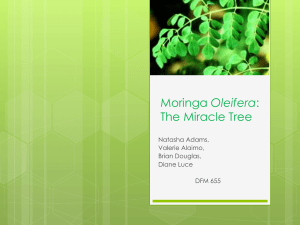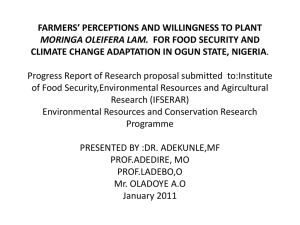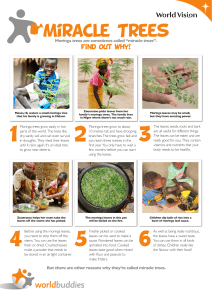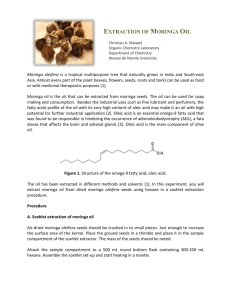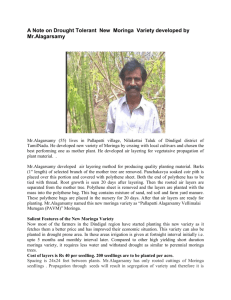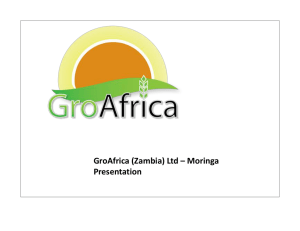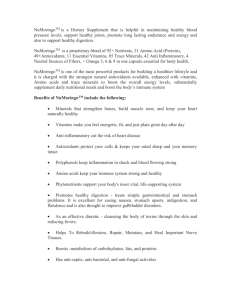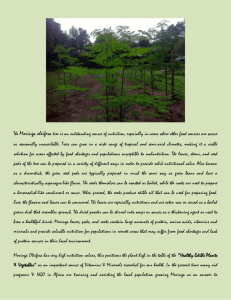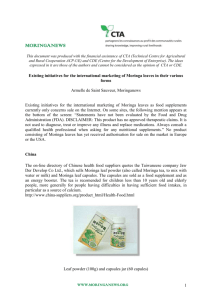Word, 292 Kb - Moringanews
advertisement
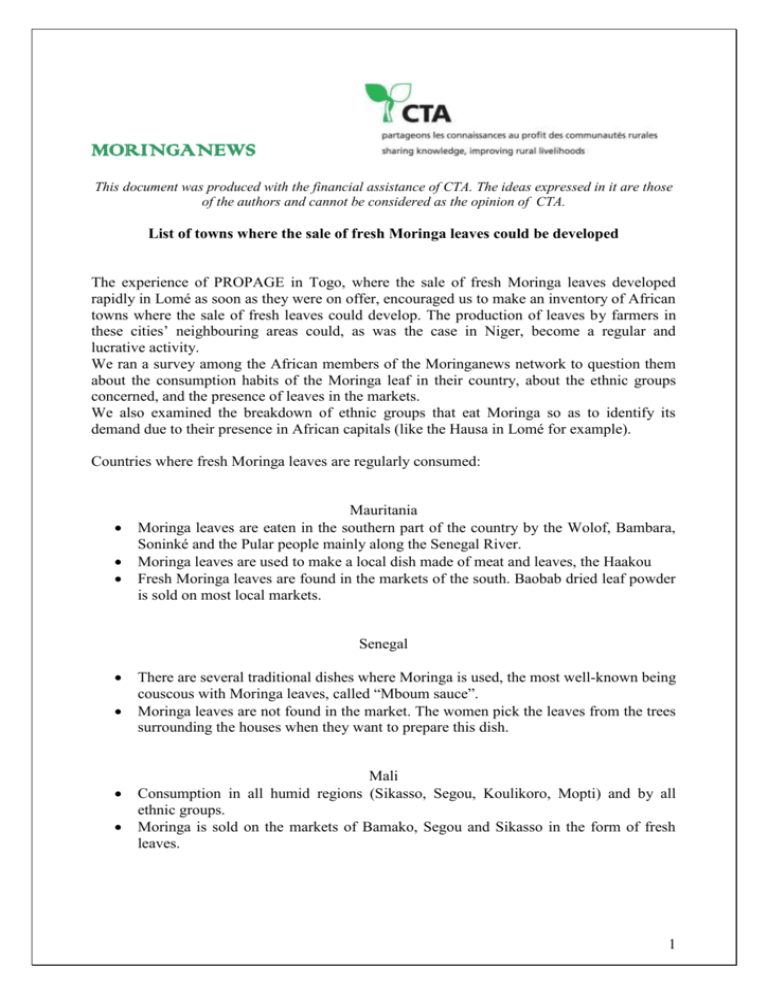
MORINGANEWS This document was produced with the financial assistance of CTA. The ideas expressed in it are those of the authors and cannot be considered as the opinion of CTA. List of towns where the sale of fresh Moringa leaves could be developed The experience of PROPAGE in Togo, where the sale of fresh Moringa leaves developed rapidly in Lomé as soon as they were on offer, encouraged us to make an inventory of African towns where the sale of fresh leaves could develop. The production of leaves by farmers in these cities’ neighbouring areas could, as was the case in Niger, become a regular and lucrative activity. We ran a survey among the African members of the Moringanews network to question them about the consumption habits of the Moringa leaf in their country, about the ethnic groups concerned, and the presence of leaves in the markets. We also examined the breakdown of ethnic groups that eat Moringa so as to identify its demand due to their presence in African capitals (like the Hausa in Lomé for example). Countries where fresh Moringa leaves are regularly consumed: Mauritania Moringa leaves are eaten in the southern part of the country by the Wolof, Bambara, Soninké and the Pular people mainly along the Senegal River. Moringa leaves are used to make a local dish made of meat and leaves, the Haakou Fresh Moringa leaves are found in the markets of the south. Baobab dried leaf powder is sold on most local markets. Senegal There are several traditional dishes where Moringa is used, the most well-known being couscous with Moringa leaves, called “Mboum sauce”. Moringa leaves are not found in the market. The women pick the leaves from the trees surrounding the houses when they want to prepare this dish. Mali Consumption in all humid regions (Sikasso, Segou, Koulikoro, Mopti) and by all ethnic groups. Moringa is sold on the markets of Bamako, Segou and Sikasso in the form of fresh leaves. 1 Niger Moringa leaves are very commonly consumed by the Hausa and Djerma, in the southern regions of the country, especially Niamey and Maradi. Fresh, dried (entire) and cooked leaves are to be found in the markets of practically all towns in the country (in the north they are found dried only). Moringa sauce, known as Kopto, consists of cooked leaves, peanut paste, onions and chilli. Agricultural production supplies the market regularly with Moringa leaves, it is a major form of economic activity (wholesale markets, dried leaves transported over long distances). Nigeria Consumption in the northern regions of Nigeria, by the Hausa and the Pular. Moringa leaves are sold in most towns of the 21 states in the north of Nigeria and in the federal capital. The are used in sauces and soups, mainly as a dried leaf powder. Leaves are cultivated in the northern region (Kano, Katsena) and are actively traded in the dried form, especially exported to Niger. Cameroon A lot of Moringa trees are to be found in the agroforestry parklands located to the north of the Adamaoua plateau. The leaves are eaten by the Koma in the Alantika mountains, the Duupa in the Poli massif and the Mafa in the Mandara mountains. The sale of leaves is insignificant and is limited to local markets. Ghana Consumption in the northern regions of Ghana (north, northwest and northeast regions). The Dagatis in the Northwest region consider Moringa to be their traditional dish. In the Northwest region (Wa and its villages), fresh Moringa leaves are sold in the markets along with other types of leaves. Moringa leaves are the first to be sold. Cooked Moringa leaves are also sold in the markets. Togo, Benin Moringa is known to and eaten by several ethnic groups, especially those in the north of the country and the Hausa. Moringa leaves are part of the alimentary habits for most people in Benin. Fresh leaves are to be found in the markets of Benin, 100 FCFA the pile, or cooked (150 FCFA for a small packet). 2 Conclusion Moringa leaves are eaten, fresh or dried, in practically all of the Sudanese and SudanoSahelian region which goes from Senegal to northern Cameroon. The main consumer ethnic groups are the Hausa, Djerma, Pular and Wolof, then the Bamabara, Soninke. Ethnic groups not included in our survey but who probably eat the leaves given their proximity to zones where they are eaten are the Malinke, Senoufo and Gourma. Map of the zone where Moringa leaves are eaten (initial approximation) Marketing of Moringa leaves for everyday food could be developed (according to an in-depth local survey) especially in Dakar, Nouakchott and Bamako. In those three countries, Moringa is eaten regularly among some ethnic groups who would buy it if they could find it in the markets of the capital. Local production would be possible with irrigation as is the case around Niamey, if not the leaves could be produced farther to the south and sold in the capital once dried. Ouagadougou could develop along those lines, but we have received no information on the consumption of Moringa in Burkina. In Accra, Cotonou and Lomé, marketing could be developed for the northern populations living in those capitals. Production could be in the immediate vicinity of the towns without irrigation. Abidjan could also be in the same situation but we have received no information from the Ivory Coast. In Yaoundé, finding Moringa leaves on the market could also interest people originally from the north of the country. In Nigeria and Niger, production and marketing are already well developed. 3
